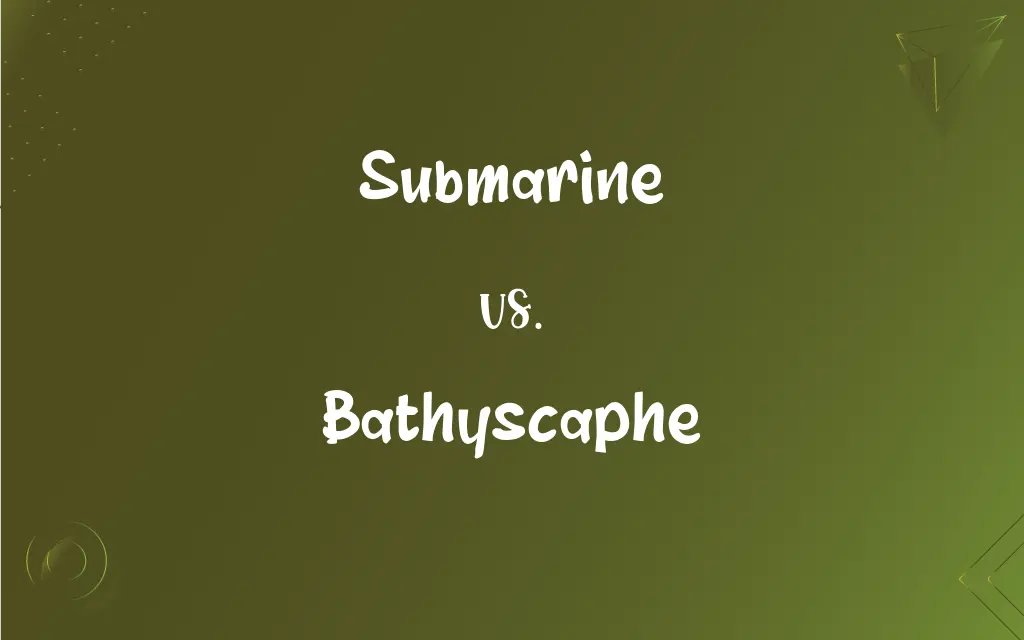Submarine vs. Bathyscaphe: What's the Difference?
By Janet White & Aimie Carlson || Updated on May 20, 2024
A submarine is a watercraft designed for underwater operations, typically for military or research purposes, while a bathyscaphe is a deep-sea submersible designed specifically for exploring extreme ocean depths.

Key Differences
A submarine is a versatile, self-propelled vessel capable of underwater operations for extended periods. It is commonly used by navies for reconnaissance, combat, and patrol missions, but it can also be used for scientific research. A bathyscaphe, on the other hand, is a specialized submersible designed to reach and explore the deepest parts of the ocean. It is typically used for scientific exploration and deep-sea research.
Submarines are built for long-term missions and can house crews for weeks or months. They have life support systems, living quarters, and facilities to sustain their crew. Bathyscaphes are designed for short-term missions with limited space, usually accommodating only a few people for brief periods, focusing on scientific instruments and research equipment.
In terms of design, submarines are more streamlined and agile to navigate underwater efficiently. They are equipped with torpedoes and other defense mechanisms if used for military purposes. Bathyscaphes, however, have a spherical pressure hull to withstand extreme deep-sea pressures and are not built for speed or combat but rather for descending to and exploring the ocean floor.
Operationally, submarines can perform a variety of tasks, including stealth missions, surveillance, and underwater combat. They are versatile and can travel both underwater and on the surface. Bathyscaphes are highly specialized, limited to deep-sea exploration missions, and are typically deployed from a mothership.
Comparison Chart
Primary Use
Military operations, research
Deep-sea exploration
ADVERTISEMENT
Design
Streamlined, agile
Spherical pressure hull
Depth Capability
Moderate to deep
Extreme depths
Mission Duration
Long-term
Short-term
Crew Capacity
Larger crew
Small crew
Mobility
High mobility and speed
Limited to vertical movement
ADVERTISEMENT
Submarine and Bathyscaphe Definitions
Submarine
Used in both military and research roles.
Scientists used a submarine to study marine life.
Bathyscaphe
Capable of withstanding extreme underwater pressure.
The bathyscaphe's hull is specially designed to endure deep-sea pressure.
Submarine
(Nautical) A vessel that is capable of operating submerged.
Bathyscaphe
A submersible designed for deep-sea exploration.
The bathyscaphe descended to the ocean's deepest trench.
Submarine
A submarine sandwich.
Bathyscaphe
Operates with limited crew capacity.
The bathyscaphe carried two scientists for the mission.
Submarine
(Baseball) A pitch that is thrown with a low sidearm or underhand motion.
Bathyscaphe
Used for scientific research at great depths.
Researchers used a bathyscaphe to collect samples from the ocean floor.
Submarine
Beneath the surface of the water; undersea.
Bathyscaphe
Specialized for vertical movement in the ocean.
The bathyscaphe slowly descended to explore the abyss.
Submarine
Thrown with or characterized by a low sidearm or underhand motion
A submarine-style pitcher.
Bathyscaphe
A free-diving deep-sea vessel consisting of a large flotation hull with a crewed observation capsule attached to its underside, usually capable of reaching the deepest parts of the ocean.
Submarine
To attack by submarine, especially with torpedoes.
Bathyscaphe
A self-propelled deep-sea diving submersible for exploring the ocean depths, consisting of a crew cabin similar to a bathysphere suspended below a float filled with a buoyant liquid such as petrol.
Submarine
(Sports) To knock down with a blow to the legs.
Bathyscaphe
Navigable deep diving vessel for underwater exploration
Submarine
(Baseball) To pitch (a ball) with a low sidearm or underhand motion.
Submarine
To slide, drive, or be thrown under something
Seats designed to prevent passengers from submarining under their seat belts in a crash.
Submarine
To ride in or serve as a crew member of a submarine.
Submarine
Existing, relating to, or made for use beneath the sea.
Submarine
Hidden or undisclosed.
A submarine patent
Submarine
(baseball) Of a pitch, thrown with the hand lower than the elbow.
Submarine
A boat that can go underwater.
Submarine
A kind of sandwich made in a long loaf of bread.
Submarine
(baseball) A pitch delivered with an underhand motion.
Submarine
Any submarine plant or animal.
Submarine
(informal) A stowaway on a seagoing vessel.
Submarine
(intransitive) To operate or serve on a submarine.
Submarine
(transitive) To torpedo; to destroy with a sudden sneak attack.
Submarine
To sink or submerge oneself.
Submarine
To slide forwards underneath one's seat belt (during a crash or sudden stop).
The seatback should always be up while driving so that the occupant doesn't submarine and potentially suffer severe internal injury.
Submarine
Being, acting, or growing, under water in the sea; as, submarine navigators; submarine plants.
Submarine
A submarine plant or animal.
Submarine
A submarine boat; a ship that can travel under the surface of the water. Most such ships are ships of war, as part of a navy, but submarines are also used for oceanic research. Also called sub and (from the German U-Boot) U-boat.
Submarine
A stowaway on a seagoing vessel.
Submarine
A submarine sandwich.
Submarine
A submersible warship usually armed with torpedoes
Submarine
A large sandwich made of a long crusty roll split lengthwise and filled with meats and cheese (and tomato and onion and lettuce and condiments); different names are used in different sections of the United States
Submarine
Move forward or under in a sliding motion;
The child was injured when he submarined under the safety belt of the car
Submarine
Throw with an underhand motion
Submarine
Bring down with a blow to the legs
Submarine
Control a submarine
Submarine
Attack by submarine;
The Germans submarined the Allies
Submarine
Beneath the surface of the sea
Submarine
A watercraft designed for underwater operations.
The navy deployed a submarine for the reconnaissance mission.
Submarine
Capable of long-term underwater missions.
The submarine stayed submerged for several weeks.
Submarine
Equipped with advanced navigation systems.
The submarine navigated through the ocean using sonar.
Submarine
Built for stealth and combat.
The submarine avoided detection during the operation.
FAQs
What are submarines primarily used for?
Submarines are used for military operations, including reconnaissance and combat, as well as scientific research.
What is a submarine?
A submarine is a watercraft capable of underwater operations, often used for military or research purposes.
What are bathyscaphes primarily used for?
Bathyscaphes are used for deep-sea exploration and scientific research.
How do submarines and bathyscaphes differ in design?
Submarines are streamlined and agile, while bathyscaphes have a spherical pressure hull for deep-sea pressure resistance.
Are bathyscaphes used for combat?
No, bathyscaphes are specialized for exploration and not equipped for combat.
What is a bathyscaphe?
A bathyscaphe is a submersible designed for deep-sea exploration, capable of reaching extreme depths.
How do the depth capabilities of submarines and bathyscaphes compare?
Submarines operate at moderate to deep depths, while bathyscaphes can reach extreme ocean depths.
How many crew members can bathyscaphes accommodate?
Bathyscaphes have limited space, typically accommodating only a few people.
What type of mobility do submarines have?
Submarines have high mobility and can travel both underwater and on the surface.
What is the typical mission duration for a bathyscaphe?
Bathyscaphes are designed for short-term missions, usually lasting a few hours.
How many crew members can submarines accommodate?
Submarines can house larger crews, often dozens of people.
Can bathyscaphes be used for scientific research?
Yes, bathyscaphes are specifically designed for deep-sea scientific research.
What is the typical mission duration for a submarine?
Submarines are built for long-term missions, capable of staying submerged for weeks or months.
What type of mobility do bathyscaphes have?
Bathyscaphes are limited to vertical movement in the ocean.
Can submarines be used for scientific research?
Yes, submarines can be used to study marine life and underwater environments.
What kind of life support systems do submarines have?
Submarines have comprehensive life support systems to sustain crews for extended periods.
What kind of life support systems do bathyscaphes have?
Bathyscaphes have basic life support systems for short-term missions.
How do submarines and bathyscaphes handle pressure?
Submarines handle moderate underwater pressure, while bathyscaphes are designed to withstand extreme deep-sea pressures.
Are submarines used for combat?
Yes, submarines are often equipped with torpedoes and other defense mechanisms for combat.
What is the primary advantage of a bathyscaphe over a submarine?
The primary advantage of a bathyscaphe is its ability to explore the deepest parts of the ocean.
About Author
Written by
Janet WhiteJanet White has been an esteemed writer and blogger for Difference Wiki. Holding a Master's degree in Science and Medical Journalism from the prestigious Boston University, she has consistently demonstrated her expertise and passion for her field. When she's not immersed in her work, Janet relishes her time exercising, delving into a good book, and cherishing moments with friends and family.
Co-written by
Aimie CarlsonAimie Carlson, holding a master's degree in English literature, is a fervent English language enthusiast. She lends her writing talents to Difference Wiki, a prominent website that specializes in comparisons, offering readers insightful analyses that both captivate and inform.































































